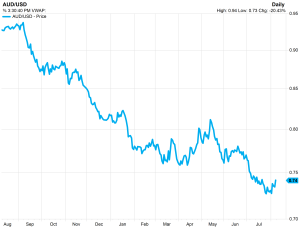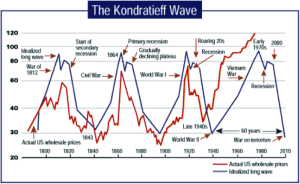If we took a five-minute helicopter view of the global economic landscape, what would we have observe? Starting from the country of the rising sun, we could say that Japan has been struggling for 25 years now to find its pace, and still may have a lot of work to do in its recalibration efforts. Stimulus (whether fiscal or monetary) can only go so far before its externalities start developing their own side effects, which may be worse than the original disease. Moving on to China, we would see a slowing economy, with central authorities trying to calibrate a smooth landing (which historically has never been achieved in any land). Going a little bit further south to Australia, we could clearly see the effects of the Chinese slowdown, most evidently in the value of the Aussie against the USD, as the graph below demonstrates.
As we start moving west and going over the seas, we could clearly see turmoil brewing in Indonesia, the Philippines, Malaysia and the rest of Southeast Asia. An exception would probably be India, if it listens to its wise central banker (Raghuram Rajan) and is also able to carry out the much needed reforms that could unleash a wave of dormant capital, attract additional sources, and catalyze the incomes of its citizens, onto many other countries.
As the helicopter moves up north to the country of Nitup (a.k.a. Russia), the fiscal holes create a wave that shakes the pilot from his seat. The commodities downturn is nothing but a part of a new cycle in formation, whose identity may still be unknown to the marketplace. While we still struggle to understand the nature of those waves (such as the one portrayed below, among others), it seems that the investment landscape’s psyche cannot cope easily with the fact that fiat money cycles have a rationale of their own when they go on high gear either due to geoeconomic or geopolitical reasons.
As the helicopter moves over the EU, it cannot escape us that Mario Draghi is simply trying to implement the policies of Japan and the US in a land defined by dysfunction. The great European experiment is being transformed in front of our own eyes into a disaster whose repercussions are outside even the statistical outliers’ range.
In the new era that nurtures this wave in formation, fiat money is used not just for bailouts but also as an economic steroid while risk is transformed into uncertainty. While this transformation takes place, the helicopter brings us to North America where the Canadian landscape takes on the consequences of the commodities’ downturn, and the U.S. tries to recalibrate its role as a locomotive in case that the Chinese decide to divest from US securities in an effort to enhance their status in the world and to position themselves geoeconomically and geopolitically (the latter by steering trouble in South China Sea).
As we move south, the pilot reminds us that the Latin and South American landscape has changed. It no longer produces just generals, but also other goods and services. However, the reality quickly sinks in. The land does not have an escape velocity to be rescued from the wave in formation, which comes at a point where we need to start moving back east and meet the African continent.
The land is promising. After all, it is blessed with natural resources that can endow a bright future, if only the rule of law could prevail and be implemented by honest governments. If seeds are properly planted and patient capital moves in to fertilize the land, not only an economic transformation is feasible, but also decades-long prosperity can trickle down to other economies.
The pilot has decided that the trip will end in the Middle East. After all he reminds us “that’s where civilization started”. The landscape by all standards is in a mess. Jerusalem, we are told, is being transformed into a cup of dizziness.
How then should we invest? Passiveness may be becoming passé, especially at a time when bond market liquidity is experiencing a significant downturn as investors understand that by holding bond funds they do not actually hold bonds but rather securities with unknown durations, and an asset class that represents third parties’ liabilities.
Preparing for the new wave in formation requires diligence, pro-activeness, and the recalibration of an investment strategy that is flexible, durable, and adaptable in an ever-changing landscape where black and white swans are long gone.


